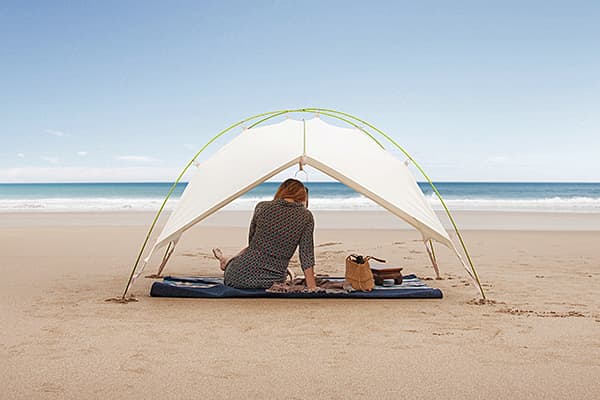Glamping is a very attractive and popular way to experience the outdoors, often without sacrificing comfort or convenience. Some feedback we’re proud of is that people often say our Crescent beach canopy looks like a glamping-style, portable beach tent.
However, many of the products used in glamping are not eco-friendly or environmentally sustainable. This is a problem, as glamping is becoming increasingly popular and is having a growing impact on the environment.
Here are some of the main reasons why most glamping products are not eco-friendly:
They are often made of synthetic materials. Synthetic materials, such as polyester and nylon, are derived from petroleum, a non-renewable resource. They also release harmful chemicals into the environment when they are produced and disposed of.
Cotton canvas fabric is often used in glamping tents. While cotton is a natural material, it is not very eco-friendly. Cotton production requires a lot of water and pesticides, and it can contribute to deforestation. Additionally, cotton canvas tents are often treated with chemicals to make them waterproof. These chemicals can leach into the environment and pollute waterways. Our Cresecent beach canopy has a coating that is water resistant but also tested and PFAS-Free.
They are often made in factories with poor working conditions. Many glamping products are made in developing countries where workers are paid low wages and often work in unsafe conditions. Thankfully, our product manager lives a short 30 min drive away from our manufacturer and we can be sure this is not the case for our products. Taiwan is a reasonably wealthy country, fair wages are paid to laborers and safety standards and employee regulations are well enforced. We visit regularly and can attest to that directly ourselves.
They are often packaged in excessive amounts of plastic. The packaging for glamping products often uses a lot of plastic, which is a major source of pollution. They are often not durable and need to be replaced frequently. This leads to unnecessary waste.
What can be done to make glamping more eco-friendly?
There are a number of things that can be done to make glamping more eco-friendly. Glamping companies can use more sustainable materials, such as recycled polyester or bamboo. They can also source their products from factories with good working conditions. Glamping companies can also reduce their reliance on plastic packaging. Finally, glamping companies can encourage their guests to reduce their waste and recycle.
Here are some specific tips for making your glamping experience more eco-friendly:
Choose a glamping company that uses sustainable materials and practices.
Bring your own reusable water bottle and utensils.
Pack your own snacks and food.
Recycle and dispose of your waste properly.
By following these tips, you can help to make glamping more eco-friendly and sustainable.
Photo by Lucija Ros on Unsplash




